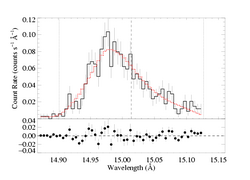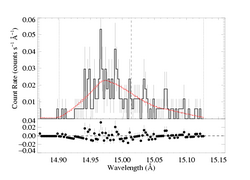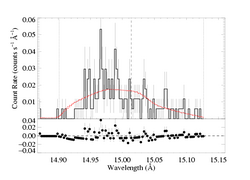Fe XVII 15.014 Angstroms
Models with anisotropic porosity
Note: Both MEG and HEG are being fit simultaneously
Same continuum fit as we used for the non-porous and isoporous models: n=2, best-fit norm=1.71e-3.
Note that the opacity bridging law used for these isoporosity fits is Rosseland.
Note that the above parameters don't agree exactly with those from the baseline (non-porous) fit, despite the fact that the above model has hinf=0. The parameter values are very close, though. The slight difference is just a result of the relative flatness of the fit statistic in the portion of parameter space surrounding the global minimum.
Here are the 68%, 90%, and 95% joint confidence limits on hinf and taustar. The asterisk represents the best-fit model, shown as the red histograms on the above two plots.
Models with anisotropic porosity provide such a bad fit, that even modest values of the porosity length are ruled out. And consequently, allowing a non-zero porosity length does not affect the confidence contours in taustar-uo parameter space. So we do not show a new version of that plot here.
Forcing a fit with taustar=8, the value implied by the literature mass-loss rate:
Note that ΔC=42 (compared to the global best-fit model, which has zero porosity length), highly ruling out this model.
Back to main page.
last modified: 28 April 2008




